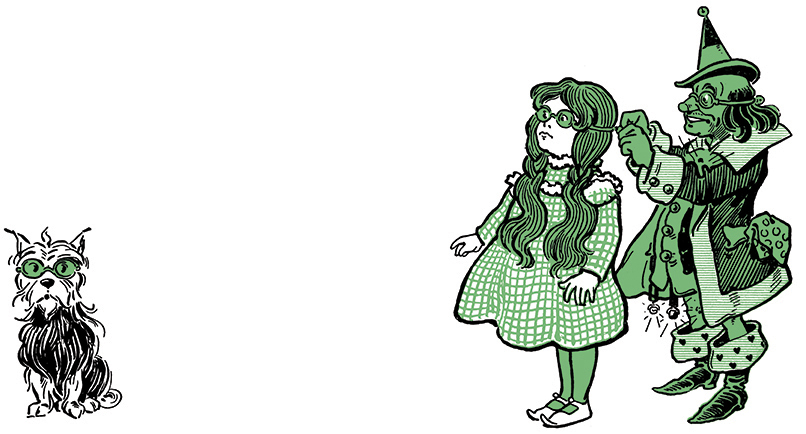The Winnerfu Warlock o Oz

By L. Frank Baum, translated into North-East Scots by Sheena Blackhall
First edition, 2018. Illustrations by W. W. Denslow. Dundee: Evertype. ISBN 978-1-78201-218-4 (hardcover), price: €31.95, £28.95, $43.95.Click on the book cover on the right to order this book from Amazon.co.uk!
Or if you are in North America, order the book from Amazon.com!
Also available in Cornish, in Esperanto, in Hawaiian, in Ido, in Irish, and in English.
| “I’m the Guairdian o the Yetts, an since ye demand tae see the Gran Oz I maun takk ye tae his Palace. Bit first ye maun pit on the glaisses.” | “I am the Guardian of the Gates, and since you demand to see the Great Oz I must take you to his palace. But first you must put on the spectacles.” | |
| “Foo?” speired Dorothy. | “Why?” asked Dorothy. | |
| “Because gin ye didnae weir glaisses the brichtness an glory o the Emerant Toon wid blin ye. Even them fa bide in the Toon maun weir glaisses nicht an day. They’re aa steekit up, fur Oz sae ordered it fin the Toon wis first biggit, an I hae the anely key that’ll unsnib them.” | “Because if you did not wear spectacles the brightness and glory of the Emerald City would blind you. Even those who live in the City must wear spectacles night and day. They are all locked on, for Oz so ordered it when the City was first built, and I have the only key that will unlock them.” | |
| He opened the muckle boxie, an Dorothy saw that it wis stappit wi glaisses o ilkie size an makk. Aa o them hid green glaiss in them. The Guairdian o the Yetts fand a pair that wid jist fit Dorothy an pit them ower her een. | He opened the big box, and Dorothy saw that it was filled with spectacles of every size and shape. All of them had green glasses in them. The Guardian of the Gates found a pair that would just fit Dorothy and put them over her eyes. | |

|
||
| The Winnerfu Warlock o Oz is L. Frank Baum’s tale o a wee quine caad Dorothy, fa wi her tyke Toto is cairriet by a furlywin frae Kansas tae the fey an bonnie lan o Oz. Here she ettles tae veesit the Emerant Toon tae sikk its heid bummer, a warlock caad Oz, tae sen her back hame again. On the wey she faas in wi a Tattiebogle, fa’s sikkin harns; a Tin Widmannie, fa wints tae hae a hairt; an a Cooardy Lion, fas ae wint is tae hae virr. The wee pairty encoonter mony mishanters an mervelous happenins on the wey, bit win tae the Emerant Toon safe, their success bein doon tae the thochtfuness o the Tattiebogle, the douce care o the Tin Widmannie, an the virr o the Cooardy Lion. This is the buik ahin the weel kent 1939 film—that differs frae the oreeginal buik in a fair fyew weys! | The Wonderful Wizard of Oz is L. Frank Baum's story of a little girl named Dorothy, who with her dog Toto is carried by a tornado from Kansas to the strange and beautiful land of Oz. Here she decides to visit the Emerald City to ask its ruler, a wizard called Oz, to send her back home again. On the way she meets a Scarecrow, who is in search of brains; a Tin Woodman, who wishes to have a heart; and a Cowardly Lion, whose one desire is to possess courage. The little party encounter many dangers and marvelous adventures on the way, but reach the Emerald City in safety, their success being due to the thoughtfulness of the Scarecrow, the tender care of the Tin Woodman, and the fearlessness of the Cowardly Lion. This is the book that inspired the famous 1939 film -- which differs from the original book in quite a few ways! | |
|
This full-colour buik hauds the oreeginal illustrations by William Wallace Denslow that wir scanned frae copies o the first edeetion. There’s 24 colour plates an 150 text illustrations, mony localized inno the Scots leid. The buik his bin typeset in a wey like thon o the first edeetion, wi a puckle typographic cheenges fur the reader nooadays.
|
This full-colour book contains the original illustrations by William Wallace Denslow which were were scanned from copies of the first edition. There are 24 colour plates and 150 text illustrations, many localized into the Irish language. The book has been typeset a fashion similar to that of the first edition, with some typographic improvements for the modern reader. | |